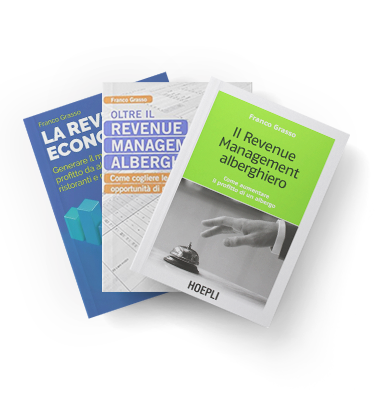The selling price is often considered as data that comes from the perception of the hotelier rather than the market. There is improper talk of a fair or correct price for the type of facility, based on the services offered and the competitor’s prices.
When bookings do not arrive
When bookings do not arrive, it is the responsibility of the poor service offered, the period of the year, the historic period, the inability of the manager/director, the sales channels that no longer work as they used to, the territorial tourist administration that fails to invest in the destination. And so on and so forth.
But it is very rare for someone to say that the price they applied or the reasoning they made on prices is wrong.
All the motivations listed thus far are false, but they affect sales very marginally. Of course, if everything were to go well, it would all be easier. But that is like saying that I failed an exam even though I had a haircut and a shave, arrived early, bought a nice suit and smiled at the examiner, neglecting the central fact, which is whether I studied little or badly.
Determining the price at which to sell the time for using our rooms (because this is what makes up a hotel facility) requires quite some attention and it is necessary to start from the historic information available to us. Here I would like to clarify two aspects and objections made. If a facility is new and has no historic data, we have to hypothesise sales prices based on experience and then monitor so as to see which necessary adjustments are to be made immediately. There is no other way! The other objection concerns the fact that statistic data is not an absolute truth and things change from year to year.
If the objective is to improve results…
This may be true, but your objective is to improve the results obtained in the previous year, considering that there may be variables making this objective easier or more difficult. Let us take 2017: there are many bank holidays and Easter came round in the middle of April, hence situation that did not appear in 2016; nor will they in 2018. These are things I must consider when I set myself objectives for improvement day by day.
What should we analyse to understand the sales price?
When these due premises have been made, we can see what I’d like to analyse so as to understand the sales price, for every single day of the year and not for periods or seasons.
Let us analyse how we reached the point of selling that given number of rooms and whether there are possibilities for the situation to repeat itself in the following year.
Let us, for example, take a day from 2016, Wednesday 12 October, and think about how we can start to sell Wednesday 11 October 2017 (because the day of the week is to be compared and not the date). Depending on where your hotel is situated, there will even be completely different situations, but the thinking to be made is very similar.
Out of 70 hotel rooms, we have sold 50, hence 20 empty rooms.
The first objective is to manage to sell + than 50 rooms, going for 70 rooms. But let use see how this 50-room occupancy could be made up. If we imagine that we have 13 business-clientèle rooms, we should hypothesise that we will also have more or less the same number of rooms next year. For greater security, we should check the other Wednesdays from this period so as to understand whether this was just chance or this is a realistic number of sold rooms.
In this case the price will be the same, or as per convention, or as % of discount on the sales price and the bookings are highly likely to arrive towards the date, which means all the more reason why we should consider them as sold and leave them to one side for themselves.
If, on the other hand, we are talking about leisure clientèle, so 15 tourist rooms, we should think differently: once we have checked that this is a normal number of rooms sold – on average for this period – we should consider whether it is possible to sell any more, as here – unlike for business – the price should be thought of with the aim of selling more, and probably lowered with respect to the starting one of the previous year.
So as to be able to obtain this result, we should move many months earlier, possibly 12: the earlier you start, the more possible it will be to reach the objective. There is no reason to wait to put the rooms up for sale.
What about the groups?
Let us imagine that we have housed a group of 25 rooms for that Wednesday: this variable is very important because it involves a group linked to a series of groups and we can hypothesise that we will also have them the following year and – probably – quite soon, so we will have the bookings calendar with its programme. We have to do all we can so that this will materialise. So, if it is all about meeting the operator’s needs, this is what we have to do.
But let us suppose that the matter is more complicated: the group has been occasional and I cannot be sure that it may come back again next year. At this point we have 25 more rooms to sell in comparison with the past year and we can only think of two solutions: the first is to start putting the sales on line immediately at far lower rates than those at which they started the previous year, because I have a lot of rooms to sell on a very weak request day and the only lever I have is the price one; the second possibility is to contact all the possible group sector operators, proposing very seductive prices, but requesting a guarantee deposit (the economic advantage we concede must be a significant one). Very similar thinking goes for the possible rooms sold through Tour Operators: if they have sold so little, it is worth thinking about more appealing rates.
As you can see, we are making logical suppositions, but there is no certainty; neither can there be. The only certainty we have is that, if we move early on and well, we shall trigger a virtuous circle that will lead to our having greater on line visibility (mainly on the Otas), which will bring more and more bookings, both intermediate and – to a lesser degree – disintermediate, raising the comments that will foster future bookings.
What happens when occupancy is complete?
We have had the example of a high-occupancy, but not complete, situation. If we had sold all of 70 rooms, our thinking would be very similar, apart from the fact that we would be starting to talk about raising the prices.
This is because, before we can start raising the prices, we must ensure that we we have sold all the rooms. In this second case, we should start thinking of optimising sales and, to do so, we should reduce the number of rooms sold at lower rates so as to leave space for those sold at higher rates.
This applies to all segments, individual or groups. We will find ourselves in a situation where we will have more requests for available rooms and we should start selling from a price slightly lower than last year’s average one, paying maximum attention as we should then progressively raise the prices where possible and have started at higher prices, where – on the other hand – they cannot be raised over time as with, for example, the Tour Operators.
We have analysed the logic to follow so as to define the starting sales prices, but we have not spoken about numbers because, to do so, it would be necessary to have specific data. In any case, this is the logic to follow so as to obtain the best possible results. Try it and see!





